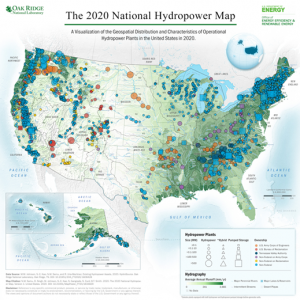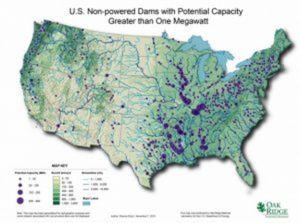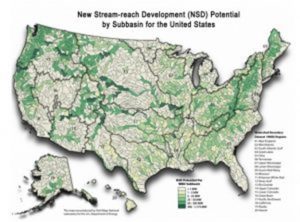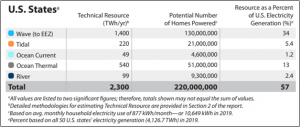WHAT GEOGRAPHIC AREAS ARE BEST SUITED FOR HYDRO? IS THERE A U.S. HYDROPOWER “MAP”?
The 2020 National Hydropower Map pictured below shows the capacity of the existing fleet of hydropower facilities in the U.S. by ownership.

Source: Oak Ridge National Laboratory (HydroSource), 2020[1]
While hydropower already provides 6–8% of the nation's electricity, more potential hydropower resides in our country’s flowing waters to provide clean electricity to communities and cities across the United States. The following map illustrates non-powered dams located in the U.S. with potential hydropower capacity greater than one megawatt. The 80,000+ non-powered facilities represent the vast majority of dams in the country. More than 90% of dams are used for services such as regulating water supply and controlling inland navigation, and lack electricity-generating equipment. There are over 50,000 suitable non-powered dams with the technical potential to add about 12 gigawatts (GW) of clean, renewable hydropower capacity. The 100 largest capacity facilities—primarily locks and dams on the Ohio, Mississippi, Alabama, and Arkansas rivers operated by the U.S. Army Corps of Engineers—could provide 8 GW of power combined.[2]

Source: Department of Energy, Water Power Technologies Office[3]
The New Stream-reach Development (NSD) Potential map pictured below shows the new stream reaches by sub basin for the United States.

Source: Department of Energy, Water Power Technologies Office[4]
U.S. Marine and Hydrokinetic Resource Potentials
While marine energy technologies are still at early stages of development, there is still an immense resource potential across the nation’s coastlines and rivers. A large portion of wave energy is located along the Pacific shorelines (California, Oregon, Washington, Alaska, and Hawaii). Tidal energy could play a major role in Alaska’s electricity generation and could contribute power in Washington state and Atlantic states. Ocean current energy mainly from the Gulf Stream, has the potential to provide reliable power to homes in North Carolina, South Carolina, Georgia, and Florida. Ocean thermal energy could offer power for parts of the Atlantic coast as well as the Gulf Coast states, Hawaii, and the U.S. Pacific territories. The nation’s river resources can be harnessed without the need for dams or river diversions to provide power throughout the country.[5]
The table below displays the technical power of potential U.S. marine energy resources.

Source: National Renewable Energy Laboratory, 2021[6]
Maps that illustrate assessments of these various marine and hydrokinetic resources can be found here.
Updated by Erin Bennett, June 2022

Comments are closed.